Full-time job plus part-time job most satisfactory combination

In two thirds of couples, both partners held a paid job in 2007. Among couples with children, the most common combination turned out to be a full-time job plus a part-time job. These couples indicate to be pleased with the distribution of work between both partners. Among young couples without children, it is common for both partners to work on a full-time basis.
Combination full-time job plus part-time job increasingly popular
Over the past fifteen years, the proportion of couples combining a full-time and a part-time job has risen from 27 percent in 1992 to 45 percent in 2007. As a result, the proportion of couples with only one full-time working partner was reduced from 49 to 27 percent over the same period.
In 92 percent of dual-income couples, the male partner is working on a full-time basis and the female partner on a part-time basis. Altogether, the proportion of couples with two partners having a paid job increased from 46 percent in 1992 to 66 percent in 2007.
Labour participation of couples

For most couples the current situation is satisfactory
Most couples indicate that the current distribution of work between both partners corresponds to their wishes. The combination of a full-time and a part-time job appears to be satisfactory for over 85 percent of couples. Couples who combine two large part-time jobs are almost equally happy with their situation.
Some 18 percent of full-time working couples would like to reduce their working hours. In most cases, it is the female partner who would like to work less. One partner working full-time and one partner who does not work at all turns out to be the least satisfactory combination.
Satisfaction in couples about their participation in the labour process, 2007

Couples with children most frequently combine a part-time and a full-time job
The combination part-time job plus full-time job is most frequently found in couples with children. In 2007, more than half of couples with underage children combined a full-time job and a part-time job. Even if the children are older, one of the partners will often work on a part-time basis. Among couples with children living away from home, there is a considerable difference between younger and older couples. In nearly half of cases where the female partner is under the age of forty, both partners are working full-time. If the female partner is over the age of forty, both partners are working full-time in only 12 percent of cases.
Labour participation rate in couples by composition of the household, 2007

Kasper Leufkens